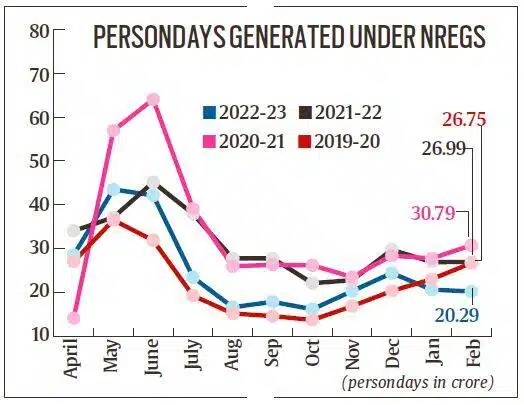Table of Contents
For the first time in four years, the number of person-days has decreased in 2024. The outbreak of COVID-19 in March 2020 followed by a nationwide lockdown led to a hike in the demand for work under NREGS,
Data from the portal of NREGS for the months of January and February show a decline in the demand for jobs below pre-covid levels for the first time in four years. There was a massive rise in demand for work under NREGS due to the nationwide lockdown being set in place to prevent the spread of COVID-19. The demand peaked in June of 2020 with around 64 crore people have generated jobs under the scheme. The monthly person-day numbers have remained high since this time.

The number of person-days generated under the scheme for January 2020, January 2021, and January 2022 are 23.07 crore, 27.81 crore,s, and 26.75 crore respectively. The number of person-days generated in January of this year is 20.69 crore, which is significantly lesser than the person-days in preceding years. The same trend was seen for the month of February too where the number of person-days for this year is 20.29 crore with the previous years.
Reason for decline Covid-19…..
Economists and statisticians from the Ministry of Rural Development have estimated multiple reasons for this decline. One is the return of migrants, the people who have migrated back to their villages during the pandemic have returned. The second could be the delayed demand for work due to the lack of adequate funds with the states.
There have been changes made in the attendance and payment systems for the scheme. Ground-level activists cite this as another reason for the drop in numbers. This may have forced people to remain without work for the past two months.
Changes in the scheme
This drop in person-days also coincides with the implementation of several new changes relating to the scheme’s implementation procedure. One of the major changes made is the mandatory requirement of marking attendance through the Mobile Monitoring System App (NMMS) put into effect from 1st Jan 2024. Geotagged and two time-stamped photos have also been made mandatory for the workers. These photos have to be uploaded to the scheme’s portal.

Aside from the implementation of a new attendance system, the Ministry of Rural Development has also made it a requirement for the deposition of wages to be made through the use of the Aadhar-Based Payment System (ABPS) in February.
The ministry has now adopted a “mixed model” for payments till 31st March 2024. In the mixed model workers can be paid through both the ABPS and National Automated Clearing House (NACH) system, but the order on the NMMS attendance system is still in force.
Criticism of new changes
The changes in the implementation of the scheme have led to criticism from many. Civil society activists have been at the forefront of providing criticism, especially for the new payment systems. A founder member of the Mazdoor Kisan Shakti Sangathan, Nikhil Dey, considers this move by the ministry as a cause of disruption which will lead to around a 30% crash in employment rates.

The decrease in employment rates to pre-COVID levels has only been the effect of a stoppage in payments due to crores of workers not being eligible for payment through the Aadhar Based Payment System. The disruption will not be eased much by the use of the mixed model of payment till 31st March. The deadline will end before any sustained relief can be provided. From the labor budget for the financial year, many states have only been allocated half the amount. Thus, the question remains whether the decrease in person-days of the National Rural Employment Guarantee Scheme is positive or not.
Have a look at this video: Covid-19: India reports highest cases in 146 days with over 1,500 new infections in a single-day













